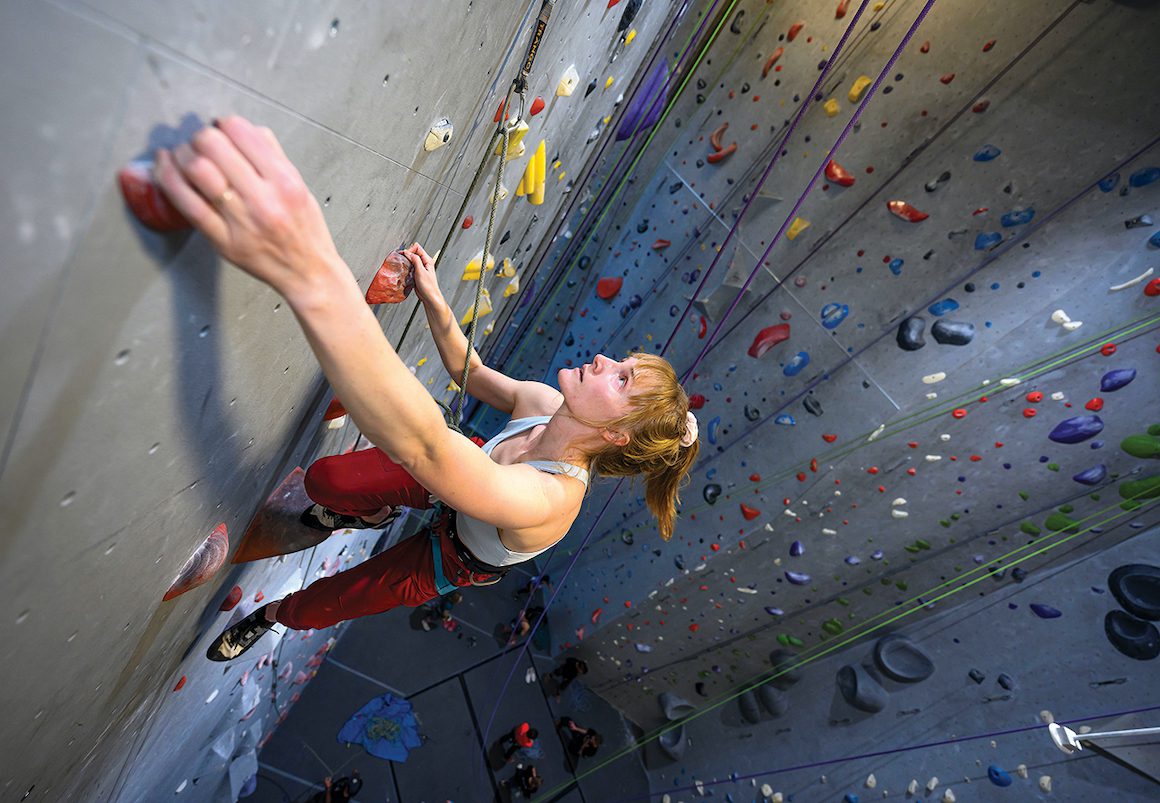
01 Jul Rise of the Gym Climber
Down the hill from the granite-strewn terrain of Tahoe, Reno’s climbing community is booming as modern indoor facilities lure newcomers and seasoned adventurers alike
On any night of the week, climbing gyms across Reno fill with men and women, young and old, crawling up weird plastic shapes bolted to walls erected inside cavernous industrial buildings.
At Mesa Rim Climbing Gym, a fog of chalk, sweat and yelps fills the five-story, 24,000-square-foot building. Children wearing team T-shirts stretch their limbs in the center of the room while 60-year-olds push themselves to new physical limits. Brand new climbers, identified by their dull gray rental shoes, show each other the ropes and check their knots.
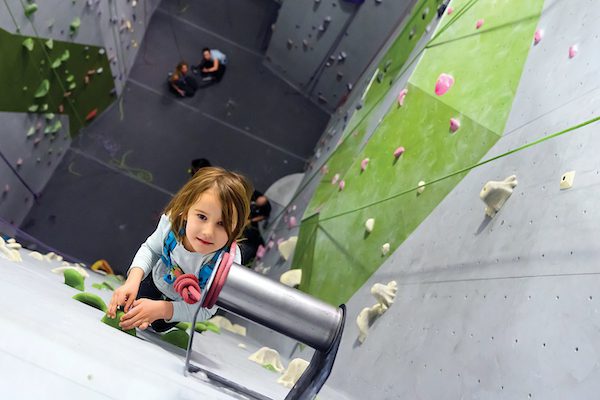
Four-year-old Quinn Liptac, whose favorite part of coming to the gym is “climbing high,” ascends a beginner route with confidence at Mesa Rim
Above it all, Kelli Hartzell focuses on the next move of her 52-foot climb. She moves with deliberate grace, reaches the end, and finally pulls her rope through two permanent carabiners at the top of the engineered wall with a satisfying “plok” sound. She gestures to the belayer below to bring her back to the ground. While her well-made black-and-white-patterned climbing shoes belie her experience, she remembers her first impressions of the gym more than three years ago.
“I was really nervous and intimidated by this gym, so it took me a long time to come, but once I got on the wall, I was really excited by climbing,” she says. “It puts me into a meditative state. It’s really the only activity I found where my brain goes completely quiet, and that’s what I love about it. I think that’s what makes climbing so addictive.”
Like Hartzell, about 1 million people across the United States tried indoor climbing for the first time since 2019, according to the Outdoor Foundation’s “Participation Trends Report.”
In Reno, indoor climbing’s ascent is even steeper. Four gyms in the city span the range of climbing types, social interests and fitness requirements. According to the report, that’s double the gyms available to people in California, Utah and Colorado, each with about one gym per 200,000 residents. Las Vegas, with its 2 million people, currently only supports three gyms despite its proximity to Red Rock Canyon State Park, home to 2,500 natural climbing routes.
When the view expands to the greater Northern Nevada/Tahoe area, there are seven climbing gyms available to a population of about 580,000.
“I can’t come up with a better place to live with a strong community between here, Tahoe, Yosemite and Bishop,” says Matt Othmer, co-owner of Reno’s newest bouldering gym, The Block Climbing and Fitness.
Why Climb?
Within the climbing world, there are many variations of styles and climbing methods: from climbing smaller 15-foot boulders with a pad on the ground, to climbing inside or outside with ropes protecting you from falls, to scaling 3,000-foot walls in Yosemite with no rope at all.
Each engages the mind and body in a game of physical chess, says Brian Sweeney, “chief knowledgarian of vertical empowerment” (aka director) at BaseCamp Climbing Gym in downtown Reno. When climbers approach a wall, small or tall, inside or out, they must plan how to grab holds with their hands and place their feet to reach the top.
Do I put my foot on this 2-millimeter rock chip or wrap my fingers around this protruding chunk? Do I go right where it looks easier or left where it seems more difficult? These are questions climbers must think through while ascending any wall.
“The fitness is a happy side effect,” Sweeney says.
In the gym, climbing routes are color-coded and rated by difficulty on a standardized scale based on Yosemite’s granite mountainsides. The way up is determined by a professional route setter and the climber’s technical skill, strength, height and weight. Gym routes help guide climbers through the moves and force them to learn specific skills as they progress. Easier routes emphasize overall fitness and body movement, while more difficult routes tend to train balance, hand and core strength, and body control.
“Climbing helps people with a pretty immediate body awareness,” Sweeney says. “A lot of workouts like treadmill don’t have you thinking about where your toe is in your shoe. I think climbing makes you pay more attention to your body, and that leads to better decisions about your body.”
Outside, the difficulty ratings are the same, and people like Sweeney still develop routes and climbing areas, but the lack of color coding forces climbers to decide how they want to reach the top of a route.
“It’s about personal expression,” Sweeney says. “You gotta get up the climb, but how you do that is up to you. You’re constantly redefining what you think you’re capable of.”
Gym Culture
Gyms often train people to climb outside, but recently, they’ve become an institute of their own. In the old days (say, the 1990s), most gyms were simple, no-frills facilities meant to give outdoor climbers a place to tune up for the next weekend. Rock Sport (now North Peak Climbing and Fitness) on Oddie Boulevard in Reno was that for the whole region for decades until the new generation showed up.
Now, says Sweeney, “A ton of people don’t even go outside. It’s its own discipline.”
For some, indoor climbing is all they need because it may make them feel safer, more social and fulfill their workout needs.
Wendy Colborne, a member of Mesa Rim, says the fear of injury or death outside, in addition to knowing people who have been injured or died, is enough to keep her climbing only on plastic and wood.
“Inside has always been enough for me,” she says. “Knowing I’m in a safe environment makes me more inclined to return.”
But that doesn’t mean the routes become rote.
“In the gym, it’s a new puzzle,” she says. “They do a good job refreshing the routes at Mesa, so there’s always something new every time you go.”
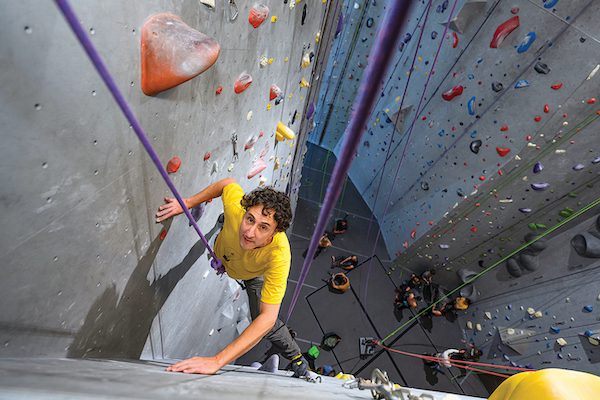
Max Shaffer climbs a difficult top rope route (rated 5.12) at Mesa Rim. Shaffer says the climbing gym factored into his decision to move to Reno from Boston
Sean Haverstock, co-owner of The Block, echoes Colborne’s sentiment.
“I really like indoor climbing not because I can’t go outside, but I just like to pull on plastic,” he says. “If I could never go outdoors again, I would still enjoy indoor climbing. That population continues to grow.”
Aside from training, a big part of the gym’s purpose is to welcome everyone. Max Shaffer, a climber who moved to Reno from Boston a few months ago, chose to move here in part because of Mesa Rim.
“Though other places have good access to climbing, I was immediately right at home here at Mesa Rim,” Shaffer says. “Everyone is super friendly, super open and very accepting.”
Modern gyms like Mesa Rim also work toward creating inclusive spaces for queer climbers, women and other previously excluded groups. Ian McIntosh, CEO and partner of Mesa Rim, says they built the gym’s brand to create a supportive space that accommodates groups of all abilities and walks of life.
“That’s a big ingredient for how communities get formed, and you don’t see that as much outside,” says McIntosh.
Othmer believes Mesa Rim likely doubled the climbing community in Reno over the last five years.
New Boulderers on The Block
Othmer and his business partner, Haverstock, opened a smaller bouldering training facility on Fourth Street and Morrill Avenue east of downtown Reno in May 2024, making it the fourth gym to open in the city, and the seventh in the Northern Nevada/Tahoe region.
“We could not exist without Rock Sport, BaseCamp and Mesa,” Othmer says. “We certainly 100 percent have them to thank for even putting us in a position where we think a facility like ours could be viable in this city.”
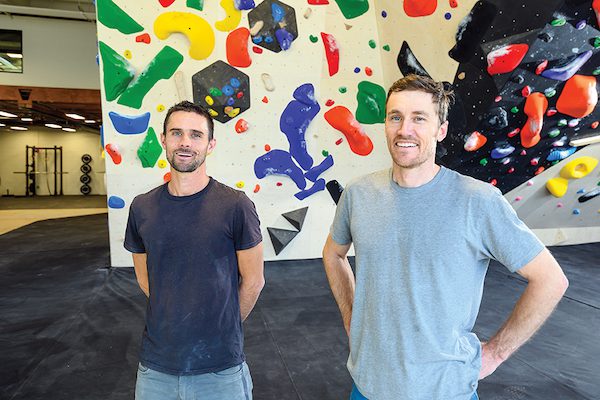
Matt Othmer, left, and Sean Haverstock are co-owners of The Block Climbing and Fitness bouldering gym in Reno
Othmer and Haverstock built The Block for climbers serious about improving their bouldering skills. Because bouldering requires very little gear—climbing shoes, chalk and a crash pad—compared to climbing with ropes, the gym also takes a more minimalist approach than others.
“We feel the climbing industry is at a point where there’s a need for more facilities and different styles,” Haverstock says. “At The Block, you’ll be surrounded by a lot of people excited to participate. They want to progress, and they want a little more focused facility.”
The gym includes a weightlifting area, traditional bouldering walls and training boards that people can control with a smartphone. These smart bouldering walls have holds that light up to map the climb from top to bottom. Users can select an existing route or build their own, which then appears on the board for them to follow. The boards are also often overhanging, making the climbing more difficult. Some of The Block’s boards even adjust on hydraulic arms to change the angle from zero to 70 degrees toward the ground, forcing people to hang while climbing.
“Since we come from an outdoor background, we want to build something that translates well to the outdoors,” Othmer says. “That being said, people are so obsessed with these boards they would be happy to dig into becoming the best Kilter Boarder in Nevada.”
The Block also houses a coworking space where students and gig workers can hang out for a quiet reprieve before jumping back on the walls. Most notably, its members can access the gym 24 hours a day with keycard access, with no staff operating the front desk after certain hours. Othmer and Haverstock hope people feel empowered to climb any time since bouldering does not require a partner. Minimal staff also helps them keep costs down to operate a lean gym, compared to the overhead required to maintain much larger businesses.
“We’re really trying to build the best facility for people through our lens,” Othmer says.
Innovations like training boards and features like coworking spaces, yoga classes and saunas would’ve been strange to climbers decades ago when the gyms were as grungy as the climbers.
“In the ’90s, it was a bunch of dirtbags in a warehouse trying to figure it out,” Sweeney says. “It used to be very punk. … But now it’s more mainstream.”
Rock climbing entered the zeitgeist in the last 10 years thanks to popular, high-quality documentary movies, upgraded modern gyms and the 2020 Summer Olympics, where professional athletes competed on the international stage in Tokyo for the first time. This year, Olympic climbers will enjoy a revamped competition in Paris, adding more awareness and nuance to the public’s understanding of the sport.
“Now climbing is so big. We really gotta step up our professional game,” Sweeney says. “It’s not an outcast network anymore.”
Managing the Ascent
As people level up inside, they’re more likely to want to climb outside, according to a member survey Mesa Rim conducted in early 2023. But the learning curve on an outdoor face can be steep without the right guide. Gyms typically discourage members from teaching each other on-premises—primarily to discourage sharing bad practices but also for liability reasons.
“We’re trying to address a gap in mentorship,” says Sweeney, who serves on the standards committee for the Climbing Wall Association. “We’re creating best practices in the climbing industry and outside to give people a broader depth of knowledge in every aspect and raise the bar for professionalism.”
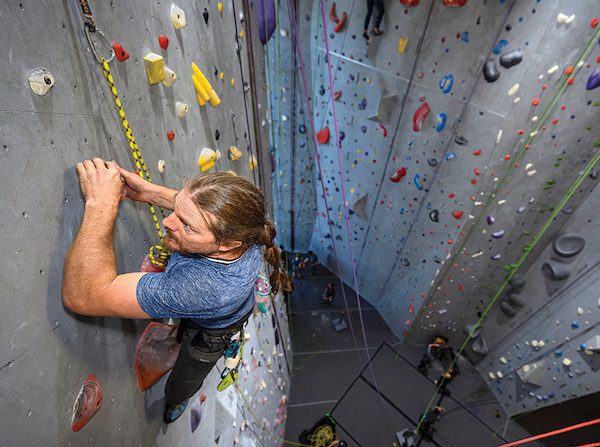
William McElmurry lead climbs a route at Mesa Rim Climbing Gym in Reno. McElmurry, who drives an 18-wheeler for a living, says he spends several hours at the gym each time he returns home
The need for more education and training becomes more pronounced as increased awareness and interest in the sport has led to a surge in outdoor climbing, which can potentially introduce danger to the inexperienced and the environment.
“Outdoors has gotten a lot more crowded,” Shaffer says. “People go straight from the gym to outdoors, and they kind of expect it to be the same thing and don’t necessarily learn the ethics.”
Sweeney wants people to enjoy the areas he and his cohort established over the last decade, but he doesn’t want to see off-leash dogs digging holes under boulders, people trampling vegetation or newcomers ignoring private property signs. Worst of all, Sweeney found chisel marks on rocks that showed people were creating new holds on challenging routes to make them more manageable.
“Overuse is becoming an issue,” he says. “It threatens the thing we love the most.”
Climbing ethics follow the seven Leave No Trace Principles, which become more critical when interacting with natural formations and rock faces that regular hikers and campers may not use.
“Climbing ethics are important because climbers are visitors and guests on someone else’s land,” states the Leave No Trace Climbing Ethics article on REI Co-Op’s website. “Whether on public or private land, climbing areas are shared with fellow climbers and often by other types of users. The continued access to climbing areas is a fragile thing.”
Graduating to the Great Outdoors
Like about 40 percent of Mesa Rim’s members surveyed, Hartzell hadn’t climbed outdoors when she was interviewed for this story in April. But that changed about two weeks later, when she took up an offer by a fellow climber to test her skills on a nearby crag.
Hartzell says the experience felt different than she expected.
“Outside, I was kind of befuddled,” she says. “I’m using my hands, feeling around. Is this the route? Am I doing this right? This rock is really sharp. The ground is not flat. I’m kind of in an odd position. It makes the gym feel pretend.”
Hartzell also realized the psychological differences of needing to use equipment to stay safe while taking fewer risks than in the gym. She returned to her routine gym climbing with renewed confidence and looks forward to taking an advanced outdoor training course in Yosemite in June.
“Now I feel braver,” she says. “Doing something harder and more novel shifted my brain and approach. Outside is the real thing. I love the gym but will always recognize that it’s different here.”
Mike Higdon started climbing in January 2019 and has a massive to-do list of routes to climb in the surrounding region that he promises himself and his partners he’ll get to this year.
Reno Climbing Gyms
Mesa Rim Climbing Center
970 Harvard Way, Reno, NV 89502
BaseCamp Climbing Gym
255 N Virginia St, Reno, NV 89501
The Block Climbing and Fitness
903 E 4th St, Reno, NV 89512
North Peak Climbing and Fitness
1901 Silverada Blvd, Reno, NV 89512




No Comments